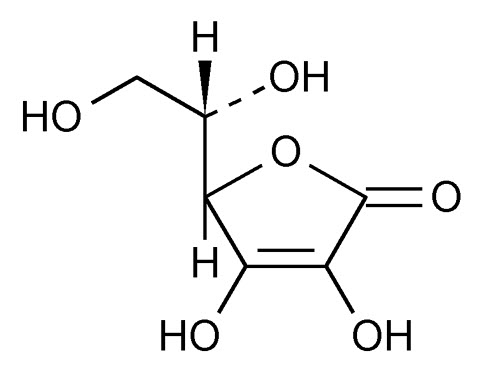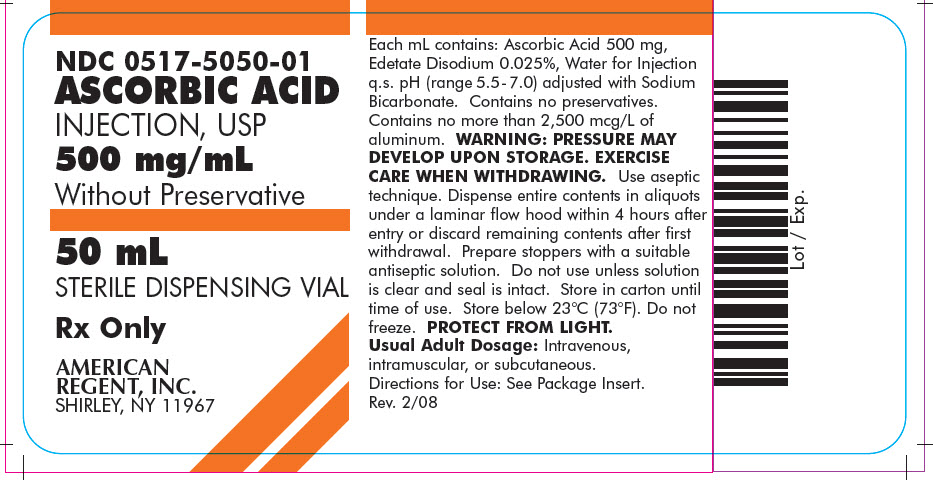ASCORBIC ACID- ascorbic acid injection, solution
American Regent, Inc.
Disclaimer: This drug has not been found by FDA to be safe and effective, and this labeling has not been approved by FDA. For further information about unapproved drugs, click here.
----------
ASCORBIC ACID INJECTION, USP
Rx Only
DESCRIPTION
Ascorbic Acid (vitamin C) is a water-soluble vitamin. It occurs as a white or slightly yellow crystal or powder with a slight acidic taste. It is an antiscorbutic product. On exposure to air and light it gradually darkens. In the dry state it is reasonably stable in air, but in solution it rapidly oxidizes. Ascorbic Acid is freely soluble in water; sparingly soluble in alcohol; insoluble in chloroform, ether, and benzene.
The chemical name of Ascorbic Acid is L-ascorbic acid. The molecular formula is C6H806 and the molecular weight is 176.13. The structural formula is as follows:

Ascorbic Acid Injection, USP is a clear, slightly yellow to yellow sterile solution of Ascorbic Acid in Water for Injection, for intravenous, intramuscular or subcutaneous use. Each mL contains Ascorbic Acid 500 mg, Edetate Disodium 0.025%, Water for Injection q.s. pH (range 5.5-7.0) adjusted with Sodium Bicarbonate.
CLINICAL PHARMACOLOGY
In humans, an exogenous source of ascorbic acid is required for collagen formation and tissue repair.
Ascorbic acid is reversibly oxidized to dehydroascorbic acid in the body. These two forms of the vitamin are believed to be important in oxidation-reduction reactions. The vitamin is involved in tyrosine metabolism, conversion of folic acid to folinic acid, carbohydrate metabolism, synthesis of lipids and proteins, iron metabolism, resistance to infections, and cellular respiration.
Ascorbic acid deficiency results in scurvy. Collagenous structures are primarily affected, and lesions develop in bones and blood vessels. Administration of ascorbic acid completely reverses the symptoms of ascorbic acid deficiency.
INDICATIONS AND USAGE
Ascorbic acid is recommended for the prevention and treatment of scurvy. Its parenteral administration is desirable for patients with an acute deficiency or for those whose absorption of orally ingested ascorbic acid is uncertain.
Symptoms of mild deficiency may include faulty bone and tooth development, gingivitis, bleeding gums, and loosened teeth. Febrile states, chronic illness, and infection (pneumonia, whooping cough, tuberculosis, diphtheria, sinusitis, rheumatic fever, etc.) increase the need for ascorbic acid.
WARNINGS
Diabetics, patients prone to recurrent renal calculi, those undergoing stool occult blood tests, and those on sodium restricted diets or anticoagulant therapy should not take excessive doses of ascorbic acid over an extended period of time.
This product contains aluminum that may be toxic. Aluminum may reach toxic levels with prolonged parenteral administration if kidney function is impaired. Premature neonates are particularly at risk because their kidneys are immature, and they require large amounts of calcium and phosphate solutions, which contain aluminum.
Research indicates that patients with impaired kidney function, including premature neonates, who receive parenteral levels of aluminum at greater than 4 to 5 mcg/kg/day accumulate aluminum at levels associated with central nervous system and bone toxicity. Tissue loading may occur at even lower rates of administration.
PRECAUTIONS
Laboratory Tests
Diabetics taking more than 500 mg of ascorbic acid daily, may obtain false readings of their urinary glucose test. No exogenous ascorbic acid should be ingested for 48 to 72 hours before amine dependent stool occult blood tests are conducted because possible false-negative results may occur.
Drug Interactions
Limited evidence suggests that ascorbic acid may influence the intensity and duration of action of bishydroxycoumarin.
Usage in Pregnancy
Pregnancy Category C - Animal reproduction studies have not been conducted with Ascorbic Acid Injection. It is also not known whether Ascorbic Acid Injection can cause fetal harm when administered to a pregnant woman or can affect reproduction capacity. Ascorbic Acid Injection should be given to a pregnant woman only if clearly needed.
ADVERSE REACTIONS
Transient mild soreness may occur at the site of intramuscular or subcutaneous injection. Too-rapid intravenous administration of the solution may cause temporary faintness or dizziness.
DOSAGE AND ADMINISTRATION
Ascorbic acid is usually administered orally. When oral administration is not feasible or when malabsorption is suspected, the drug may be administered intramuscularly, intravenously or subcutaneously. When given parenterally, utilization of the vitamin reportedly is best after IM administration which is the preferred parenteral route.
For intravenous injection, dilution into a large volume parenteral such as Normal Saline or Glucose is recommended to minimize the adverse reactions associated with intravenous injection.
The average protective dose of ascorbic acid for adults is 70 to 150 mg daily. In the presence of scurvy, doses of 300 mg to 1 gram daily are recommended. However, as much as 6 grams have been administered parenterally to normal adults without evidence of toxicity.
To enhance wound healing, doses of 300 to 500 mg daily for a week to ten days, both preoperatively and postoperatively, are generally considered adequate, although considerably larger amounts have been recommended. In the treatment of burns, doses are governed by the extent of tissue injury. For severe burns, daily doses of 1 to 2 grams are recommended. In other conditions in which the need for ascorbic acid is increased, three to five times the daily optimum allowances appear to be adequate.
WARNING:
PRESSURE MAY DEVELOP WITHIN THE VIAL UPON STORAGE. Exercise care when withdrawing and/or relieve pressure by first inserting sterile empty syringe into vial thus allowing pressure to equilibrate.
When using dispensing vials use aseptic technique. Dispense entire contents in aliquots under a laminar flow hood without delay or within 4 hours after entry or discard remaining contents after first withdrawal. Prepare stoppers with a suitable antiseptic solution. Do not use unless solution is clear and seal is intact.
Parenteral drug products should be inspected visually for particulate matter and discoloration prior to administration, whenever the solution and container permit.
HOW SUPPLIED
Ascorbic Acid Injection, USP (500 mg/mL)
NDC 0517-5050-01 50 mL Sterile Dispensing Vial Individually Packaged
PROTECT FROM LIGHT. STORE IN CARTON UNTIL TIME OF USE. Store below 23°C (73°F). Do not freeze.
IN5050
Rev. 6/07
AMERICAN
REGENT, INC.
SHIRLEY, NY 11967
PRINCIPAL DISPLAY PANEL
Container
NDC 0517-5050-01
ASCORBIC ACID
INJECTION, USP
500 mg/mL
Without Preservative
50 mL
STERILE DISPENSING VIAL
Rx Only
AMERICAN
REGENT, INC.
SHIRLEY, NY 11967

Carton
NDC 0517-5050-01
50 mL STERILE DISPENSING VIAL
ASCORBIC ACID
INJECTION, USP
500 mg/mL
Without Preservative
Rx Only
AMERICAN
REGENT, INC.
SHIRLEY, NY 11967

| ASCORBIC ACID
ascorbic acid injection, solution |
||||||||||||||||||||
|
||||||||||||||||||||
|
||||||||||||||||||||
|
||||||||||||||||||||
|
||||||||||||||||||||
|
||||||||||||||||||||
| Labeler - American Regent, Inc. (622781813) |
| Establishment | |||
| Name | Address | ID/FEI | Business Operations |
|---|---|---|---|
| Luitpold Pharmaceuticals, Inc. | 002033710 | ANALYSIS(0517-5050) , MANUFACTURE(0517-5050) , STERILIZE(0517-5050) | |